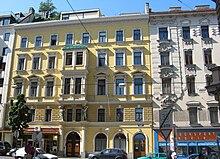Ferdinand Dehm
Ferdinand Dehm (born August 27, 1846 in Vienna ; † March 26, 1923 there ) was an Austrian architect and court architect as well as a liberal politician.
biography
Ferdinand Dehm received his training from various masters, such as the court architect Oelzelt and Ludwig Tischler from the Wiener Bau-Gesellschaft . In 1873 he received the town architect license and went into business for himself together with Franz Olbricht . The company was very successful and constructed a large number of public and private buildings. As an entrepreneur, Dehm bought land in Vienna, built houses on them and then sold them on.
From 1886 to 1895 Dehm held the office of a member of the municipal council for the 9th district as a liberal , from 1892 he was also a member of the Lower Austrian state parliament . After his partner Olbricht could no longer work in the joint company for health reasons, Dehm also withdrew and devoted himself exclusively to his political functions. He worked in various construction departments, advocated the creation of large traffic facilities and the incorporation of the suburbs into Vienna. He was also involved in humanitarian activities in the field of children's hospitals and non-profit associations. Dehm died a distinguished man and was buried in a magnificent tomb in the Weidlinger cemetery .
Ferdinand Dehm received the Franz Joseph Order in 1891 and the Ottoman Mecidiye Order in 1900 . In 1898 he became a building officer and was also chief curator of the Erste Österreichische Spar-Casse , deputy head of the Karolinen- , St. Annen- and Leopoldstädter Children's Hospital , vice-president of the Viennese construction company, vice-president and, after the death of founder Kühn, president of the first Viennese people's kitchen association.
meaning
Ferdinand Dehm built almost exclusively together with Franz Olbricht. Their buildings corresponded to historicism , with the initially stricter Renaissance forms gradually giving way to the more decorative neo-baroque. After Otto Wagner's appearance , his design principles were also adopted and from then on neo-baroque buildings with secessionist motifs were built (so-called Viennese Modern School ).
Works
- Rental house , Metternichgasse 9, Vienna 3 (1868)
- Villa , Hauptstrasse 48, Weidling (1873)
- Villa Dehm , Hauptstrasse 50, Weidling (1874)
- 1. Karolinen Children's Hospital , Schubertgasse, Vienna 9 (1878), no longer exists
- Residential house , Schlüsselgasse 3, Vienna 4 (1882)
- Residential house , Favoritenstrasse 50, Vienna 4 (1882)
- Franz Joseph Infantry Barracks , Korneuburg (1882)
- Residential house , Wohlebengasse 18, Vienna 4 (1883)
- Reconstruction and adaptation of the Mayerling Hunting Lodge for Crown Prince Rudolf (1883)
- Rental house group , Kolingasse 5 / Wasagasse 5–7 / Hörlgasse 6, Vienna 9 (1886)
- Rental house Beatrix-Bad , Linke Bahngasse 9, Vienna 3 (1888)
- Railway line Sigmundsherberg − Hadersdorf 44 km (1888–89)
- Residential and commercial buildings , Gumpendorfer Strasse 114–114a, Vienna 6 (1891)
- Rental house , Fischerstiege 10, Vienna 1 (1892)
- Residential houses , Messenhausergasse 3 and 5, Vienna 3 (1893)
- Residential and commercial building , Tuchlauben 18, Vienna 1 (1894)
- Residential and commercial building , Habsburgergasse 6–8, Vienna 1 (1897)
- Moserhof residential and commercial building , Tuchlauben 14, Vienna 1 (1898)
- Residential and commercial building , Fleischmarkt 14, Vienna 1 (1899)
- Residential and commercial building , Julius-Tandler-Platz 4, Vienna 9 (1899–1901)
- Rental house , Glasergasse 11, Vienna 9 (1900)
- Residential and commercial building , Währinger Gürtel 166, Vienna 9 (1900)
literature
- Felix Czeike (Ed.): Dehm Ferdinand. In: Historisches Lexikon Wien . Volume 2, Kremayr & Scheriau, Vienna 1993, ISBN 3-218-00544-2 , p. 5 ( digitized version ).
Web links
- Ferdinand Dehm. In: Architects Lexicon Vienna 1770–1945. Published by the Architekturzentrum Wien . Vienna 2007.
Individual evidence
- ^ First Vienna People's Kitchen Association. In: New Free Press. July 24, 1916, p. 9.
- ↑ The food supply. 28,481,000 servings in the people's kitchens. In: Illustrierte Kronen-Zeitung. May 8, 1918, p. 5.
| personal data | |
|---|---|
| SURNAME | Dehm, Ferdinand |
| BRIEF DESCRIPTION | Austrian architect and politician, member of the state parliament |
| DATE OF BIRTH | August 27, 1846 |
| PLACE OF BIRTH | Vienna |
| DATE OF DEATH | March 26, 1923 |
| Place of death | Vienna |


